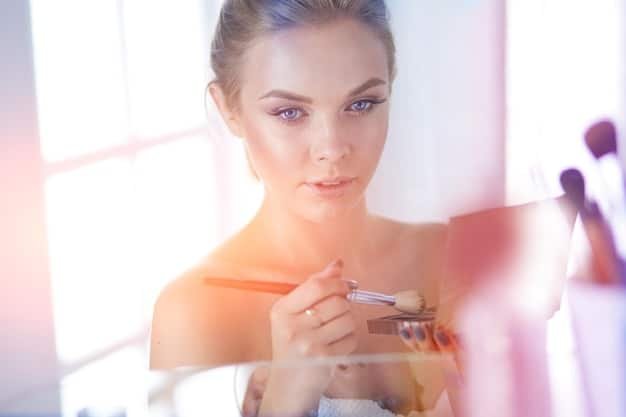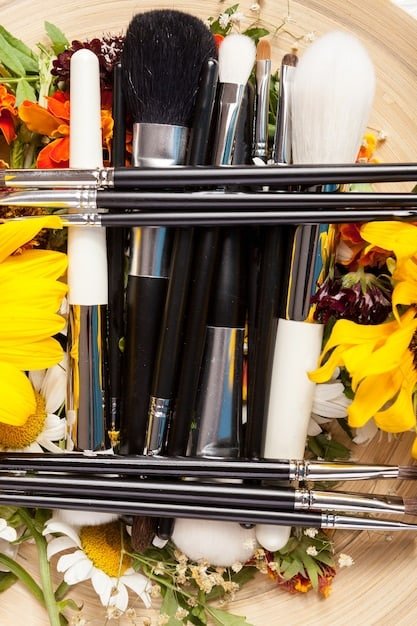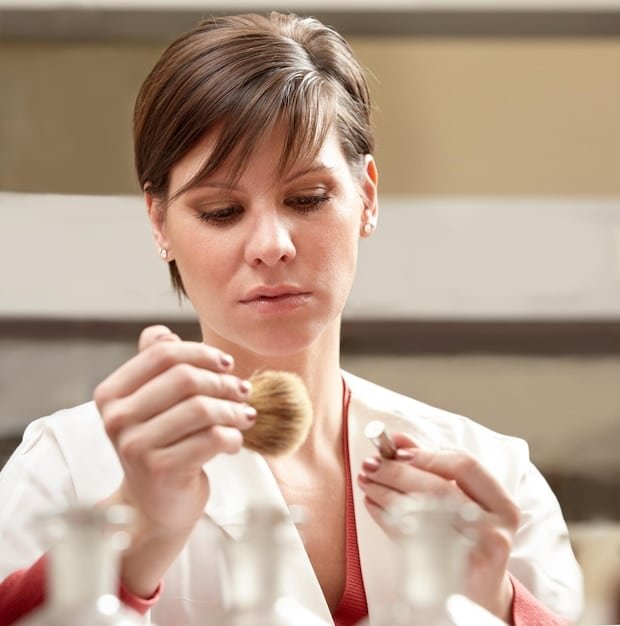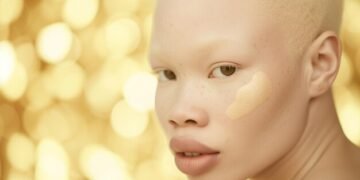Setting Powders 2025: Find the Perfect One for Your Skin

The Ultimate Guide to Setting Powders: Which One is Right for Your Skin Type in 2025? explores the best setting powder options for various skin types, helping you achieve a flawless, long-lasting makeup look with expert tips and recommendations for the coming year.
Achieving a flawless makeup look that lasts all day is a common goal, and the right setting powder is a crucial tool. Discover the ultimate guide to setting powders: which one is right for your skin type in 2025?, ensuring your makeup stays put, minimizes shine, and enhances your natural beauty.
Understanding Setting Powders
Setting powders are essential for locking in your foundation and concealer, preventing creasing, and controlling shine. They come in various formulations, each designed to address specific skin concerns. Choosing the right one can make a significant difference in the longevity and appearance of your makeup.
Types of Setting Powders
Setting powders can be broadly categorized into loose powders and pressed powders. Each type offers different benefits and application methods, catering to various preferences and skin types.
- Loose Powders: These are finely milled and provide a lightweight, airbrushed finish. They are excellent for baking and setting makeup for long periods.
- Pressed Powders: These are compact and convenient for on-the-go touch-ups. They offer a more subtle setting effect and are less likely to create a mess.
- Translucent Powders: These are colorless and suitable for all skin tones. They set makeup without adding any pigment.
- Tinted Powders: These come in various shades and can provide additional coverage or color correction.
Setting powders not only prolong the wear of your makeup but also help to mattify the skin, reducing the appearance of pores and fine lines. The key is to find a formula that works harmoniously with your skin type and desired finish.

Identifying Your Skin Type
Before choosing a setting powder, it’s crucial to understand your skin type. The right powder can enhance your complexion, while the wrong one can exacerbate issues like dryness or oiliness. Knowing your skin type helps you make an informed decision.
Common Skin Types
Skin types generally fall into five categories: oily, dry, combination, normal, and sensitive. Each requires a different approach to skincare and makeup.
- Oily Skin: Characterized by excess sebum production, leading to shine and potential breakouts.
- Dry Skin: Lacks moisture, often feeling tight and flaky.
- Combination Skin: Features both oily and dry areas, typically with an oily T-zone and dry cheeks.
- Normal Skin: Well-balanced with minimal issues.
- Sensitive Skin: Prone to irritation and allergic reactions.
Determining your skin type involves observing how your skin behaves throughout the day. Pay attention to areas of shine, dryness, and any reactions to products. Consulting a dermatologist can also provide a professional assessment.
Best Setting Powders for Oily Skin
Oily skin requires a setting powder that can effectively absorb excess oil and maintain a matte finish throughout the day. Look for formulas that are oil-free and non-comedogenic to prevent clogged pores and breakouts.
Recommended Powders
Several setting powders are specifically designed for oily skin, offering long-lasting shine control and a smooth complexion.
- Laura Mercier Translucent Loose Setting Powder: A cult favorite known for its finely milled texture and ability to control oil without looking cakey.
- Fenty Beauty Pro Filt’r Instant Retouch Setting Powder: Provides a matte finish and blurs imperfections, perfect for oily skin.
- Coty Airspun Loose Face Powder: A classic, affordable option that absorbs oil and sets makeup for hours.
When applying setting powder to oily skin, focus on areas prone to shine, such as the forehead, nose, and chin. Use a fluffy brush to lightly dust the powder over these areas, or try baking for extra oil control.
Top Setting Powders for Dry Skin
Dry skin needs a setting powder that won’t exacerbate dryness or cling to dry patches. Look for hydrating formulas with ingredients like hyaluronic acid or moisturizing oils.
Hydrating Powder Options
Finding the right setting powder for dry skin involves choosing products that add moisture rather than strip it away.
- Hourglass Veil Translucent Setting Powder: Known for its light-reflecting particles that create a luminous finish and prevent dryness.
- Givenchy Prisme Libre Loose Powder: A blend of four colors that brighten the complexion and provide a soft, hydrated feel.
- Physicians Formula Mineral Wear Talc-Free Mineral Airbrushing Loose Powder: Gentle and hydrating, perfect for sensitive and dry skin.
For dry skin, it’s best to use a light hand when applying setting powder. Focus on areas that tend to crease or where you apply concealer. Use a damp beauty sponge to press the powder into the skin for a seamless finish.

Setting Powders for Combination Skin
Combination skin requires a balanced approach, addressing both oily and dry areas. Look for a setting powder that can control shine in the T-zone while hydrating the drier areas of the face.
Balancing Act
Managing combination skin involves using different products and techniques for different areas of the face.
- RCMA No-Color Powder: A versatile powder that works well on all skin types, including combination skin. It sets makeup without adding color or texture.
- Makeup Forever Ultra HD Microfinishing Loose Powder: Provides a flawless, airbrushed finish and controls shine in the T-zone.
- Cover FX Perfect Setting Powder: Offers a balance of oil control and hydration, suitable for combination skin.
Apply setting powder strategically, using a lighter hand on the drier areas and focusing on the T-zone for oil control. Consider using different powders for different areas of the face to achieve the best results.
Application Techniques and Tips
The right application technique can significantly enhance the effectiveness of your setting powder. Whether you prefer a brush or a sponge, mastering these tips will help you achieve a flawless finish.
Brush vs. Sponge
The choice between using a brush or a sponge depends on your skin type, the desired finish, and personal preference.
For a natural, diffused look, use a large, fluffy brush to lightly dust setting powder over the face. This technique is ideal for dry and normal skin types.
For more precise application and oil control, use a damp beauty sponge to press the powder into the skin. This method is great for oily and combination skin, especially when baking.
Baking Technique
Baking involves applying a thick layer of setting powder to areas prone to creasing, such as under the eyes, and allowing it to sit for 5-10 minutes before dusting off the excess. This technique helps to set makeup and brighten the skin.
To bake effectively, use a hydrating concealer and a generous amount of setting powder. After dusting off the excess, blend the remaining powder into the skin for a seamless finish.
| Key Point | Brief Description |
|---|---|
| ✨ Skin Type | Match the powder to your skin type for best results. |
| 🧽 Application | Use brush for light coverage, sponge for baking. |
| ☀️ Finish | Choose matte or luminous based on preference. |
| 🔎 Ingredients | Opt for hydrating or oil-absorbing formulas. |
Frequently Asked Questions
▼
Setting powder is used to lock in foundation and concealer, prevent creasing, control shine, and create a smooth, long-lasting makeup finish. It helps to keep your makeup in place throughout the day.
▼
Consider your skin type. Oily skin benefits from oil-absorbing matte powders, while dry skin needs hydrating, luminous options. Combination skin requires a balanced approach, targeting oily areas only.
▼
Yes, setting powder can be used to control shine and even out skin tone, even without foundation. Apply a light layer to areas prone to oiliness for a natural, matte finish.
▼
Loose powder provides a lighter, airbrushed finish and is ideal for baking. Pressed powder is compact and convenient for touch-ups, offering a more subtle setting effect. Choose based on preference.
▼
Reapply as needed to control shine. Oily skin may require touch-ups every few hours, while dry skin may not need reapplication at all. Monitor your skin and adjust accordingly.
Conclusion
Selecting the right setting powder is a personalized journey, deeply intertwined with understanding your unique skin type and desired makeup finish. As we look ahead to 2025, the importance of choosing the right setting powder remains paramount for achieving a flawless and long-lasting makeup look.





